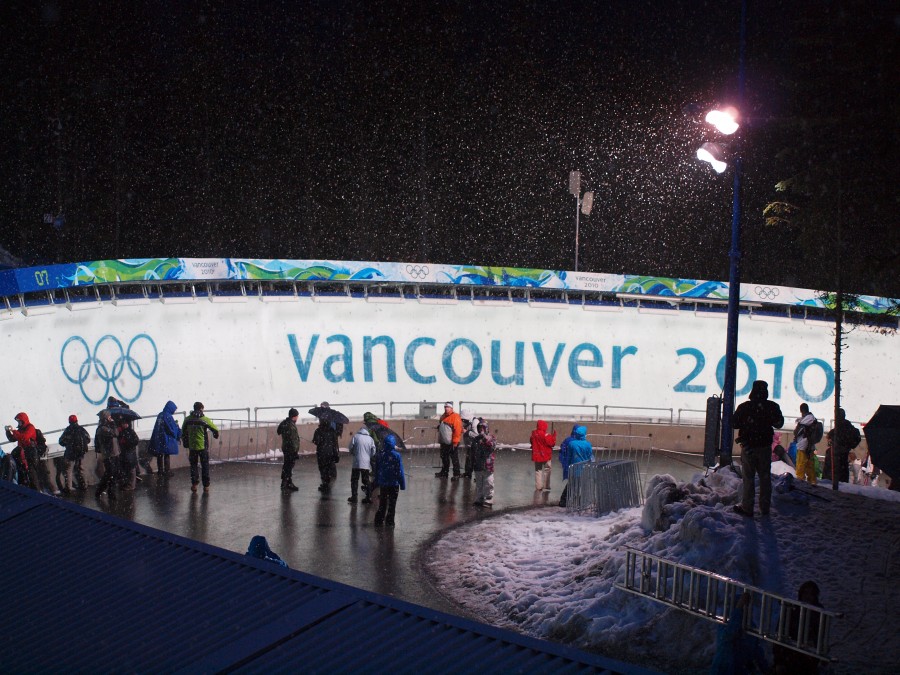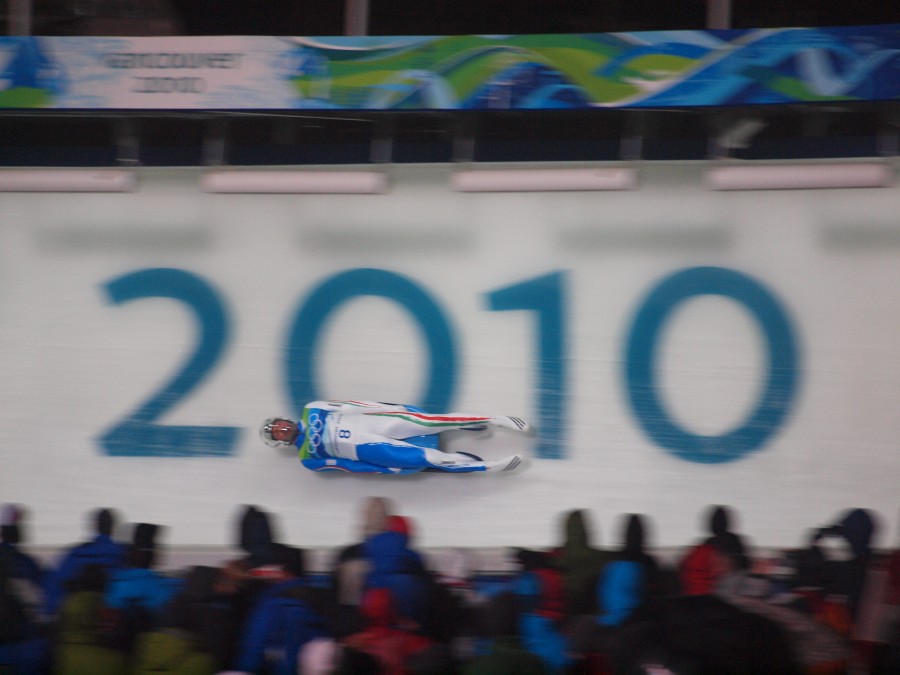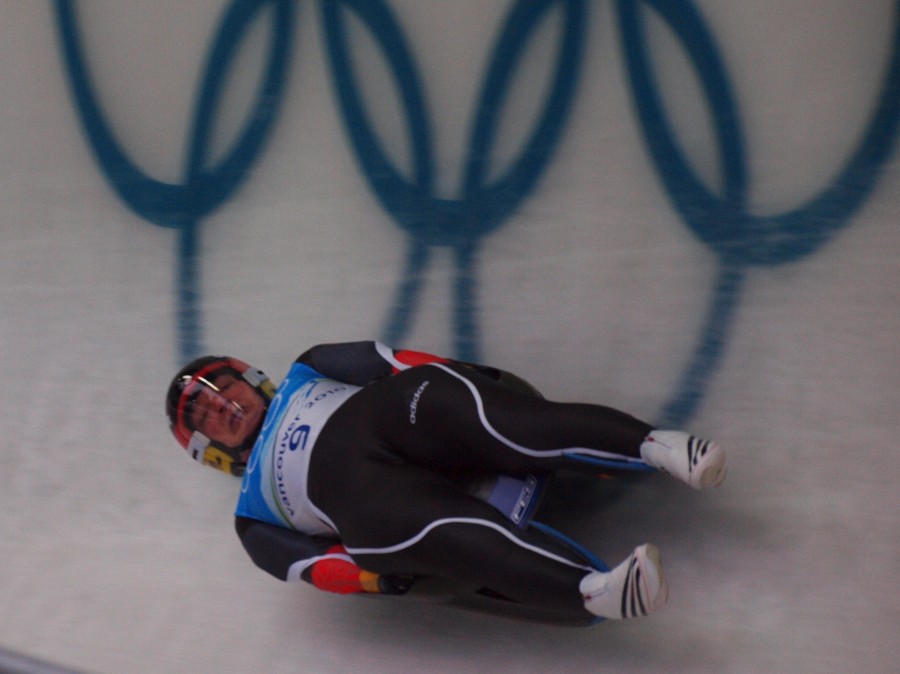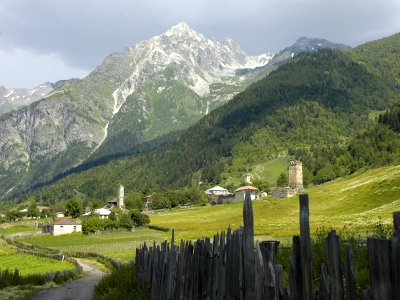The post Exploring The Caucasus Mountains On The Chechen Border: It’s Not What You’d Think appeared first on The Expeditioner Travel Site.
]]>
Small black figures walk up and down the jagged ridge. A patch of blue sky peers down onto the blue-green slopes of the bare mountainside before it disappears behind the grey, cotton clouds. A cool wind brushes against my skin and carries the smell of burnt wood and charcoal from my denim jacket I had placed over the barbecue last night to dry it out.
“See those?” Giorgi points to the ridge and takes a drag from his cigarette. “That’s Chechnya. That’s the border patrol. “
I grew up with the news about the Chechen conflict in the ’90s. I was too young to understand it at the time, but I’m still haunted by the images of war-torn Grozny, and of the dead victims and buildings torn apart by shrapnel.
In the Argun Valley on the Georgian side of the border in the Greater Caucasus Mountains, the Chechen frontier overlooks an untouched landscape of metamorphic mountains, where pieces of shale flake off onto empty roads. A palette of green, colored by grass-covered mountains and a mix of deciduous and evergreen trees is set against the browns and greys of the rocks. This is definitely not the Chechnya I remember from the BBC broadcasts.
Our group scatters about the Anatori crypts. I peer through the tiny barred windows of the small stone houses to the browned and aged bones lying in a disordered heap.
“Was this a cemetery?” I ask.
“They were sick people,” says Giorgi. “They came here to die willingly, to stop the disease from spreading. It was a part of Khevsur culture.”
I swallow and look away. I can’t imagine coming here willingly to die alone, even amidst the beauty of this region.
Khevsureti is tucked away in the Caucasus Mountains in the north of Georgia and is only accessible during the summer. Traversing up the “roads” made out of bulldozed mountain debris pressed down by tire tracks, it is easy to see why the pass is closed during the winter. Personally, I find it terrifying enough during the summer.
Seven hours from Tbilisi our marshrutka, a Soviet-era minibus, sluggishly climbed up the Datvis-Jvaris pass in thick fog, before carrying us down narrow and unstable dirt tracks running over stretches of mountainsides colored in shades of brilliant emerald. I have been in Georgia for just over a week and I am hungry to see much of the country. However, no amount of preparatory guidebook reading had readied me for Georgian roads and driving.
The graveled roads are empty, and the only sign of civilization manifests in the crumbling medieval towers that blend into the landscape.
The sky turned grey and the rain hammered against the bus. At this point, my legs tingled and my rear end went numb. The road curved into hairpin bends, running parallel to the whitewater river, until after another hour, we arrived at Shatili, the largest settlement in Khevsureti.

50 defensive towers make up the village, and some even date as far back as the 6th Century. The stone and mortar towers climb up the side of the hill in dark brown tones, tainted by the heavy rain and water trickling down the inclined streets. Many towers are abandoned, and the population, comprising a dozen or so families, reside in the modern wooden houses dotting the perimeter. Some towers are restored, distinguishable by their wicker balconies.
The water seeped through my denim jacket within seconds, and I fought against the slippery steps carrying us up into the fortified village while Georgian soldiers looked at us curiously from under their camouflage caps.
Our guesthouse is located inside a restored tower, and the rooms are basic. The wide gaps between the wooden beams give us very little privacy, but I’m surprised and grateful that we have generator-supplied electricity, since I don’t even have mobile phone coverage here.
In the evening, the smell of barbecue smoke flittered over the towers. Our guides prepared a traditional Georgian supra, a feast, under a wooden canopy at the top of the village. Our selection of Georgian food included salad served up with a walnut dressing, tangy local sheep’s cheese, barbecued meat, Georgian flatbread with a chewy bite, stewed vegetables — naturally washed down with litres of Georgian wine.
Niko, our driver, pulled out a plastic water bottle filled with clear liquid.
“Tonight, we will take the Georgian toasting tradition,” Giorgi translated.
The Georgian tradition involves toasting with wine, or worse, chacha, a Georgian moonshine made from grape seeds that should come with a health warning. My liver cried as Niko poured two fingers of chacha into my plastic cup.
“I want to make a toast to Georgia, this beautiful country: garmajos,” Giorgi said before downing his glass.
“Garmarjos,” we repeated in unison. The chacha burned my throat. It reminds me of pálinka, a Hungarian fruit spirit my grandfather used to force on my British father every time he visited my mother’s family. At least chacha takes the bite off the damp cold.
I am grateful for my minimal hangover as we stroll around the Anatori Crypts. The others aren’t so lucky. Giorgi is wearing sunglasses to cover his red eyes.
We head back to the bus. Niko is peeling a mushroom he just picked off the roadside.
“Is good,” he says while holding out a piece of raw mushroom for me to try.
My stomach curdles at the thought. I’ve already had difficulty stomaching the khachapuri for breakfast, Georgian cheese bread, which still clogs my arteries. I politely decline.
We bundle into the bus and drive to Mutso, the last Khevsur village accessible by car.
Our road takes the marshrutka across streams and into dirt tracks with small boulders of rock we push into the river by hand. The trail leads past abandoned villages and wild marijuana fields.
Niko grabs a stalk of cannabis and passes it back to us.
“Pull a leaf off and rub it in your hand,” Giorgi says.
The cannabis leaf crushes under the palm of my hand, releasing the strong, recognizable scent.
Giorgi’s vision shifts towards the abandoned military vehicle.
“Throw it out the window,” he says, “If the soldiers catch us, we’re in serious trouble.”
We toss the crumpled stem and I lean forward.
“Is it true that the people are still pagan?” I ask as the bus pulls towards the base of the abandoned city. I look up through the window, but all I can see are jutting sharp rocks.
“Yes, there are shrines with animal antlers, these are offerings here. Sacrifices. Khevsurs worship the pagan gods, but they’re Christian too. It has changed very little here, even during the Soviet regime. Khevsur men still wore chainmail until the 1930s.”

The rocky mountain shadows the right bank of the transparent, fast-flowing Andakistskali River. Giorgi points to a narrow neck in the stream.
“If you want to fill up with water, do it here, it comes from the glacier.”
I bend down and hold my bottle over the small cascade. The water tastes sweet and refreshingly cold. I glance up to the mountain, and I can make out the medieval fortress crowning the top, built onto the vertical terraces of the rocky plain. Mountains close in the valley, whose snowy peaks are already located in Chechnya.
Climbing up, we pass a single wooden house.
“The last village before Chechnya,” says Giorgi, “One family lives here.”
We’re halfway up the mountain. I stop to breathe and rub my sore calves. Stone towers grow out of the mountainside against a backdrop of green, vertical slopes moving back into the valley. I hold my breath and I’m inspired to don Elvish armour and go exploring.
There is no safe path to the citadel, only tracks scattered with debris and overgrown plants. Mutso was once a major stronghold in medieval Georgia, but its towers are abandoned and open up into the sky.
In the West, this hike would have broken every single health and safety rule imaginable. I climb the sheer rock face with grooves for my feet and only dusty patches to link my fingers into. I slip. My heart plunges against my chest. I make the mistake of looking down to the pieces of rock bouncing off the mountainside into the valley below. I exhale and close my eyes. I’m almost there.
Trembling, I reach the top. I crash against the side of the shrine and the pointed edges dig into my back. I gulp down the contents of my water bottle and scan the surrounding valley.
I fall in love with the towering misty mountains covered with snow, the two tiny stone outposts that mark the border and the sunny patches on the steep valley carpeted with chartreuse green grass punctuated by glacial streams. The whisper of the wind and the call of a lone eagle is the only sound beyond the chatter of our group.
Finally my breathing steadies and I realize every bruise on my body, even the risk getting here, is all worth being a part of Khevsureti, even just for a moment.
By Jennifer Walker

About the Author
 Jennifer Walker is an Anglo-Hungarian freelance writer living in Budapest, Hungary. After a sordid past involving a PhD in Physics, she threw caution to the wind to follow her dream of writing. In 2012, she went to Tbilisi, Georgia to work at the national newspaper Georgia Today. She specializes in travel, art and culture, and writes for The Budapest Times, Kunstpedia, ARTES Magazine, The Huffington Post, GOOD Magazine. Her work has also appeared at Gadling, Viator, The Matador Network and more. To read more, visit Jenniferdeborahwalker.com or follow her on Twitter: @JDWalkerWriter.
Jennifer Walker is an Anglo-Hungarian freelance writer living in Budapest, Hungary. After a sordid past involving a PhD in Physics, she threw caution to the wind to follow her dream of writing. In 2012, she went to Tbilisi, Georgia to work at the national newspaper Georgia Today. She specializes in travel, art and culture, and writes for The Budapest Times, Kunstpedia, ARTES Magazine, The Huffington Post, GOOD Magazine. Her work has also appeared at Gadling, Viator, The Matador Network and more. To read more, visit Jenniferdeborahwalker.com or follow her on Twitter: @JDWalkerWriter.
The post Exploring The Caucasus Mountains On The Chechen Border: It’s Not What You’d Think appeared first on The Expeditioner Travel Site.
]]>The post 2010 Olympics Days 4-5: Luge (The Wildest Sport On Earth) appeared first on The Expeditioner Travel Site.
]]>
I believe I described skeleton, right here on TheExpeditioner.com, as “extreme headfirst sledding, in tights, somewhere within Avatar’s Pandora.” I still hold that to be true (stay tuned, there might be some tickets for these shenanigans in my future). So take that description, replace “headfirst” with “feet first,” and you have the most accurate picture of the sport called Luge. I snagged some tickets to the first two qualifying rounds to see what in the world this is all about.
Actually, Luge has had quite a lot of the headlines at the beginning of the Olympics, and not because of the tight outfits the lady competitors wear. In my last post I wrote about my time exploring Vancouver all day. Because of that, I missed any news from Olympicville.
It was only an hour previous to the ceremonies when I learned of the tragedy that happened on the Olympic luge course. The death of Georgian luger Nodar Kumaritashvili will forever remind us of the inherent risks involved in highly competitive, high-performance sports. There was a moment of erupting cheers in support of the Georgian athletes at Robson Square which will be one of those special moments I will always remember. In fact, right now, there is a giant statue of the Olympic rings in the middle of Whistler’s village that has become a memorial to the athlete, with flowers, candles, and a picture of him. This outpouring of sympathy from people completely unconnected to him or his country is a reminder of what the Games are about.
So with Luge on the mind of nearly everyone lately I thought I’d see if luck would shine down on me and there would be a ticket available. It was shining, there was a ticket, and I was boarding the Blackcomb gondola faster than you can say, “holy crap, was that a luger that just went by?”

After the slog through the watery snow that makes up Whistler-Blackcomb’s lower mountain and the airport-intrusive security, I finally made it the track, which was impressive itself. I know it has been the source of much controversy of late (too dangerous? Driver error?), but I’m talking about the physical track. This ribbon of icy concrete traces 4,507 feet of mountainside, now reduced to about 4,000 feet for the lugers, and drops over 500 vertical feet in the process. The mastermind behind this design has the athletes reaching speeds my Pontiac won’t even think about (really).
My only experience with luge is watching it on T.V., on the Olympics (not like ma and pa throw luge watching parties like the Superbowl). The racers gracefully glide along the finely manicured path, rolling up the banks, and skidding to a finish with ease. Well, T.V. has it all wrong, as usual. I was blown away at the sheer speed at which they passed me, the sound of the sled rails on the track, the violence of the force these things generate. This isn’t a finely edited joy ride down a slope, this is a sport seemingly always teetering on the brink of a disastrous accident. Oh, and that graceful stop we’ve all been seeing, before they shortened the track, people were outshooting the finish and being launched into the foam pit that sits at the end of the track (on a fairly regular basis according to the gentleman I was chatting with at the race).

Needless to say, I was quite impressed at the luge. The discussion around the village is still: “is the track too dangerous?” I have a feeling that question is just one of those anomalies that ends where it begins, because what I witnessed is a beautiful, crazy sport that is dangerous in and of itself.
Where was luge when I was growing up? If you put Gassy Jon in a tube of ice with a sled, I bet he wouldn’t ever be stopped.
The post 2010 Olympics Days 4-5: Luge (The Wildest Sport On Earth) appeared first on The Expeditioner Travel Site.
]]>The post Majestic Mountains, Beguiling Towers, And Lawless Bandits, Oh My appeared first on The Expeditioner Travel Site.
]]>With the disappearance of the lawless bandits and random kidnappings, what’s the most likely reason for not returning home? Try not wanting to leave.
Our friend back at the embassy in Tbilisi dutifully passed on warnings from higher-ups advising us not to go or, if we were so intrepid, to at least hire a guide. They warned us about the bandits and we listened to stories of foreigner kidnappings that went in one ear and out the other. We had done our research and decided the quest was worth the minimal risk we thought it posed to our safety.
The place in question was Svaneti, a sparsely-populated, high-altitude region of the Republic of Georgia, sandwiched between the infamous conflict areas of South Ossetia and Abkhazia. We read that the situation had grown so bad that back in 2003, after a wave of increased murders and robberies of foreign tourists, the Georgian Interior Ministry deployed a special-purpose unit to restore order in the Mestia District.
At dusk we boarded the overnight train at the Tbilisi station and shortly after dawn we rolled into the drowsy town of Zugdidi. We made our way to the makeshift bus station. Here we hesitantly handed over our passports to buy the tickets for the next part of the journey.
The woman behind the kiosk registered us as foreigners entering Svaneti and assured us there hadn’t been any kidnappings in over four years. After waiting an hour we lashed our backpacks to the rack on the dented roof and boarded the rusting van, squeezing ourselves onto one of the ripped-upholstery benches. Most of the next four-and-a-half-hour haul would wind us through a river gorge ascending past several shades of greenery.
Despite the early hour, my inquisitive and uninhibited travel partner struck up a conversation with the mixed-age crowd crammed inside the van. As the roads deteriorated, those on board became friendlier. They were teaching us some basic words in Svan, a South Caucasian language spoken only by some 30,000 inhabitants of the region. Having no written language, most Svans know Georgian and a smattering of Russian, which became our common tongue.
The unforgiving jolts and jerks of the partially paved road abruptly came to a halt. The van stopped. Everyone fiddled through his or her bag for an empty plastic bottle. Stepping out into the sunshine we stood confused, watching our new friends make their way down to a small stream.
One by one they bent down and filled their bottles from what looked to be the source of a stream. It was a spring bubbling out of the ground. “Good water?” I asked a man in my newly acquired Svan. He smiled, assuring me it was safe to drink. We couldn’t believe the water came out of the ground already carbonated. And like it or not, the mineral water in these parts has a salty, sulfur flavor that is certainly an acquired taste.
 After driving another 30 minutes slowly up the gentle grade, we entered Upper Svaneti. Here huge stone watchtowers appeared, rising out of the landscape. It seemed like most houses in the villages that speckle this long, scenic valley had one. They were mostly built in the 9th to 12th centuries to store grain and provide safety for the families from attackers. Behind the villages, in the near distance, a series of 15,000-foot mountain peaks loomed over us.
After driving another 30 minutes slowly up the gentle grade, we entered Upper Svaneti. Here huge stone watchtowers appeared, rising out of the landscape. It seemed like most houses in the villages that speckle this long, scenic valley had one. They were mostly built in the 9th to 12th centuries to store grain and provide safety for the families from attackers. Behind the villages, in the near distance, a series of 15,000-foot mountain peaks loomed over us.
Upon arrival in Mestia, the regional capital, we navigated through the town’s few streets with the help of some residents and found the family with whom we would be staying. They were pleasant, and after a cup of tea and brief chat to get acquainted, we strolled through the wide, Soviet-era streets, past the empty main square and made our way to the regional museum.
The next morning our host packed us a generous lunch and we set off for an ambitious walk. We hoped to make it to Ushguli, the highest continually inhabited village in Europe. To manage the some 40 kilometers, we would need the help of a passing vehicle for a lift.
We kept our expectations to a minimum, and with that mindset we weren’t disappointed — no cars ever passed us, on this, the only through road in Upper Svaneti. But it was all for the better. At our pace we slowly absorbed the alpine scenery: wildflower-drenched fields, a quick-flowing river, sounds of cow-bells, and sights of inviting villages along the way, all with the uneasy thought of bandits still in the back of our minds.
Soon we started climbing up the switchbacks, still with no sign of any passing cars. Almost to the pass, we came upon the calmest of ponds in a picture-perfect setting. We unpacked our lunches and ate while sitting beneath the stunning mountain backdrop.
After lunch we finished the climb to the pass and looked out into the next valley. We stood in silence. The huge expanse in front of us stifled any words that might have come out. With Ushguli only a spec on the horizon, we realized it was too far and turned around with regret.
Coming down from the pass, we saw the village of Saldashi, with its old-fashioned homesteads surrounded by large plots of land and rickety picket fences, just a few hundred meters to the north. We wandered up the dirt road and saw an elderly couple outside of their house. We looked at them. They looked at us. Out of curiosity, they called us over.
“You boys must be hungry,” the man said in Russian, prompted by his wife who must have noticed that we looked like we’d been walking for hours.
With that we were quickly introduced to the Zredeyani couple, Kolya and Julieta. With a nice plot of land big enough to raise a couple cows, some pigs, and a sufficient vegetable garden, they sustained themselves through the harsh winters.
We sat down at the table and Julieta placed a bowl of soured milk in front of us. Without a doubt it came from their cow outside. We sponged it up with homemade bread. Kolya chatted with us as Julieta sat watching the inconsistent signal on their black and white TV.
“Is it safe around here?” we inquired.
“It’s not dangerous,” he replied. “Even all throughout the night.” Of course we were talking about the bandits. Not realizing it, he answered us regarding the general safety of the area.
We drifted outside and the light of day revealed the wrinkles of Kolya’s face that had endured these cyclical patterns for decades. Pointing to the the wall, he showed us how far the snow piles up in the winter (about 3 1/2 feet). Although only early July, they were already preparing for the six-month season.
Together we looked out from the front yard as Kolya pointed out Mount Shkhara and the names of the surrounding mountain peaks and villages. But we were heading in the opposite direction, towards the valley to Mestia. We thanked Kolya and Julieta profusely and headed back down the dirt road.
We walked quickly, knowing a solid three-hour march was ahead of us. After about an hour, two guys in an old beat-up van pulled over next to us. They waved us inside, cleared off the back seat, and we hopped in. Russian once again became the lingua franca and we managed to converse despite the clamoring suspension and clouds of dust.
“So we hear Svaneti’s a dangerous place?” we shouted over the roar of the engine.
“Aww, you can’t believe everything you hear,” they shot back. “It was a bit dangerous back during the civil war, but no more.”
He followed that by listing the name of every bandit’s name he could remember.
The conversation unexpectedly halted when we pulled over without warning. We looked at each other with furrowed brows, wondering what the problem was. When we saw them reach for their empty bottles we knew exactly why. We leapt out and sauntered down to the spring. We drank our fill of the water. It tasted different this time.
“Each one has just a little bit different flavor to it,” they informed us, referring to the unique mineral content of individual springs.
45 more minutes of shakes, bumps and intermittent conversation, we were back in Mestia.
During dinner, our home-stay host — who happened to be a local government official — talked to us about our safety and security reservations after we brought up the topic for the last time.
In fact, he explained, “Svaneti was a dangerous place some five years back. Former soldiers used to hide out and watch villagers go up to Mestia to sell their vegetables. Then they would rob the villagers full of their earnings, when they returned.” He continued. “And a van load of German tourists were fired on back in 2000.”
Shock showed on our faces.
“No one was killed,” he stressed, “but it’s been quiet since 2004 . . . After that point, the region ceased being a safe-haven for criminals. Security has tightened and since then it’s been safe for both locals and foreigners.”
Our time in Svaneti had come to a close and early the next morning we wound our way back down through the steep, tree-covered river gorge with an overwhelming impression of the sheer beauty of the landscape and the warmth and hospitality of this isolated, ancient culture.
Back in Tbilisi, we reported our return to our skeptical and curious friends at the embassy. We had survived our trip to Svaneti.

The post Majestic Mountains, Beguiling Towers, And Lawless Bandits, Oh My appeared first on The Expeditioner Travel Site.
]]>